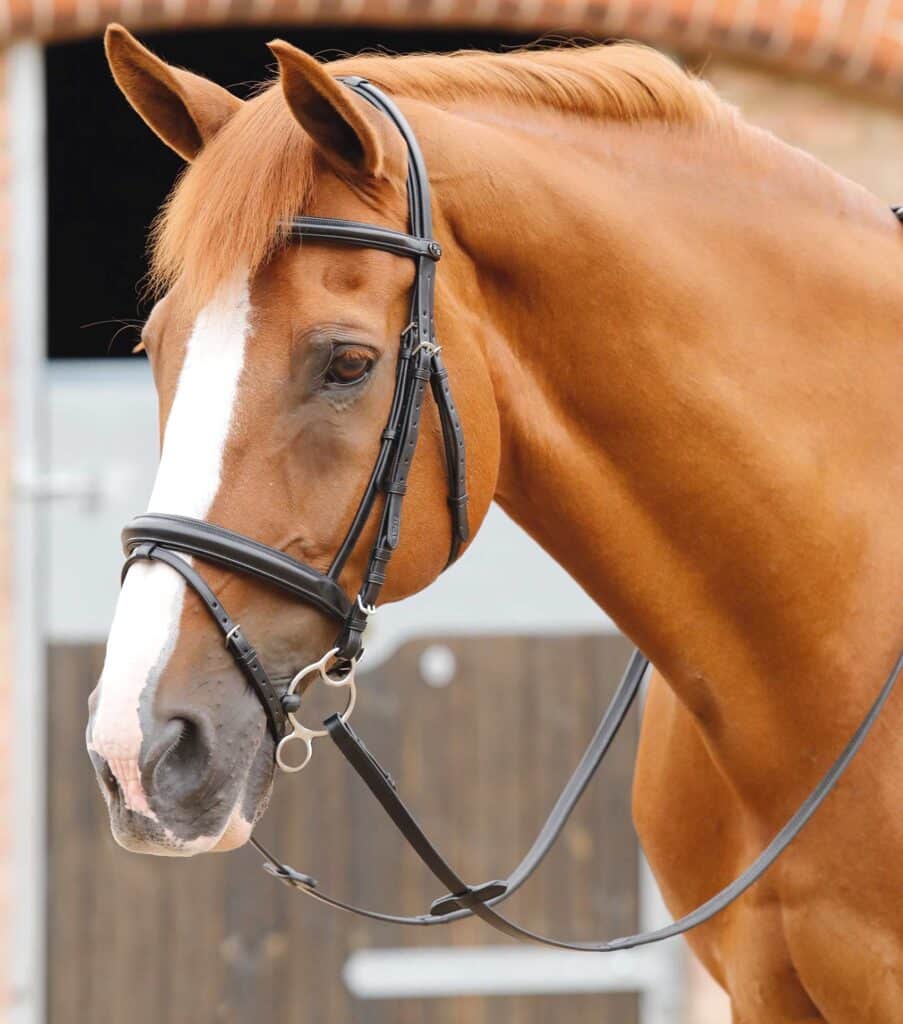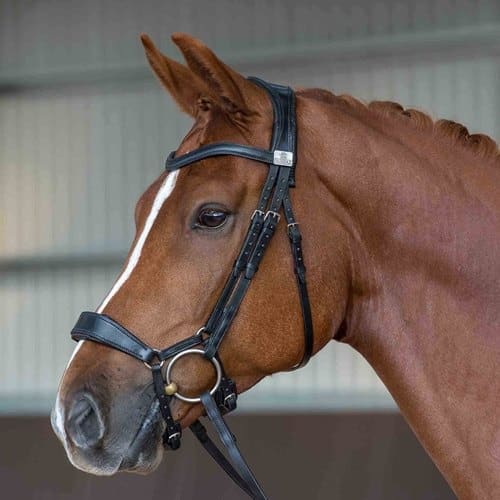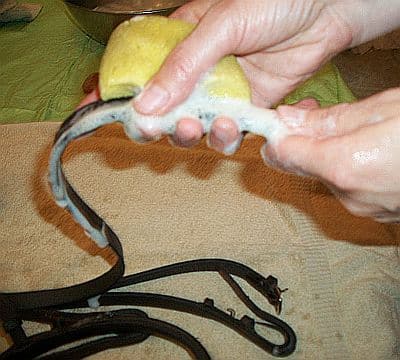Table of Contents
To properly train a bridled horse, it is essential to understand the horse’s behavior, the proper fitting, and effective communication between the rider and the horse. The bridle is an essential piece of equine equipment made up of several different components, each of which has a distinct function in directing and controlling the horse. This article will discuss the secrets of successful bridle horse training, emphasizing key components and strategies such as preventing the horse from opening its mouth and misbehaving.
What is a horse bridle?

A horse bridle is an essential piece of gear used to steer and control a horse. It typically consists of a headstall, a bit, reins, and sometimes additional straps like nosebands. The rider can communicate with the horse using the reins; the bit is placed in the horse’s mouth, and the headstall is designed to fit over the horse’s head. A thorough understanding of the components of a horse bridle is essential for practical training.
Types of Bridles
When it comes to horse training, there are many various types of bridles, and each one serves a different purpose The bridles are used to control the movement and speed of the horse. Explore how fast can a horse run by virtue of its exceptional speed in the world of racing horses.
Snaffle Bridle
The snaffle bridle is one of the most common and versatile types of bridles, particularly in English bridles. It is also one of the most popular types of bridles. Direct pressure is applied to the corner of the mouth by the snaffle bits included in this set. This bridle is highly favored because of its ease of use and efficiency in teaching fundamental commands.
Double Bridle

The double bridle is a type of bridle commonly used in advanced dressage. It consists of two bits, a snaffle, and a curb, as well as two pieces of reins. This arrangement enables more precise control and communication with the horse, making it a perfect choice for professional riders seeking perfection.
War Bridle

The war bridle is a more straightforward but harsher design that lacks a bit and focuses on pressure points on the horse’s head and face. The primary purpose of using this horse bridle is to train particular habits, and it must also be handled with care.
Bit Rings and Types of Bits
When it comes to the bridle, bits are essential components since they have an impact on the horse’s behavior and comfort. Several different types of bits are used for a variety of purposes:
Bit rings

There are rings on the bit attached to the bridle, known as bit rings. Designs such as loose rings, eggbutt, and D-ring snaffles are among the most common designs. The movement of the bit and the direction of pressure provided to the horse’s mouth are both influenced by the design of the bit.
Snaffle bits

Snaffle bits, known for their ease of use and simplicity, are an essential component of many snaffle bridles. They serve as an ideal tool for basic training as they exert pressure on the corner of the mouth and promote clear communication between the rider and the horse being trained.
Nosebands and Their Functions
Nosebands are an essential component of the bridle horse. Their purpose is to prevent the horse from opening its mouth excessively and to prevent the horse from avoiding bit pressure.
Cavesson Noseband

The Cavesson noseband is the most common form of noseband. It fits just below the horse’s cheekbones and helps stabilize the bit without exerting excessive pressure. It finds use in a variety of fields, including jumping and dressage.
Drop Noseband
The drop noseband is designed to prevent the horse from opening its mouth and crossing its jaw. It is positioned lower than the cavesson. Applying pressure in a specific place can be particularly useful for horses resistant to the bit’s pressure.
Applying Pressure

Maintaining the right amount of pressure is essential for successful bridle horse training. All three components the bit, the noseband, and the reins work together to deliver information to the horse. For instance, when the rider pulls on the reins, the bit provides pressure to the corner of the mouth or the tongue, directing the horse’s movements. It is possible to prevent the horse from opening its mouth too wide by using an appropriately adjusted Cavesson noseband. This will ensure that the bit continues to be effective.
Preventing the Horse from Evading the Bit
When training a horse to wear a bridle, a common issue is the horse trying to avoid the bit by placing its tongue over it or opening its mouth. You can address these problems by adjusting the bridle appropriately and selecting the right type of bit. For example, a properly placed drop-noseband can prevent the horse from opening its mouth and attempting to escape the bit.
Bridling a Horse

Knowing how to put a bridle on a horse is a fundamental skill. You can follow this step-by-step guide to know the exact method. Skilled riders using a double bridle can achieve a more refined control. The employment of two bits and four reins in this bridle makes it possible to give Subtle orders. When it comes to efficiently using a double bridle, experience and sensitivity to the horse’s responses are both necessary skills.
Prepare the bridle
Ensure you properly assemble all parts and clean the snaffle bits.
Approach the horse calmly
Stand beside the horse, holding the bridle in your left hand and the bit in your right.
Reins placement
Place the reins over the horse’s neck: This keeps the horse in place.
Insert the bit
To make sure that the bit can rest comfortably in the horse’s mouth; you can gently encourage the horse to open its mouth and then place the bit inside.
Adjust the headstall
To ensure the bit is correct, slip the headstall over the horse’s ears and fix the cheek pieces before adjusting the headstall.
Secure the noseband
Adjust the Cavesson or drop noseband to fit snugly but not too tightly.
Maintenance of the Bridle
Regular cleaning of the bridle ensures that it will last a long time and continue to be effective. Clean the horse bridle after each use to eliminate accumulated dirt or sweat on the various parts. Examine the leather for signs of wear and tear and replace any torn or damaged components.
The Role of the Rider

The rider has a vital role in bridle horse training to be successful. To properly communicate with the horse, it is essential to thoroughly understand the horse’s behavior and use of the bridle. Riders should work on developing a hand that is powerful but soft, exerting pressure as required without causing discomfort.
Common Challenges and Solutions
Horse resisting the bit
If a horse is resistant, check the fit of the bridle and the type of bit used. Changing the noseband or switching to a different kind of bit will frequently result in significant improvements in the horse’s performance.
Horse opening its mouth
Use a drop noseband or properly adjusted Cavesson noseband to prevent this behavior.
Horse putting its tongue over the bit
If this problem continues, position it correctly or try using a bit with a different design.
Conclusion
In conclusion, it is essential for successfully training a bridled horse to have a deep understanding of the parts of a horse bridle, the various types of bridles, and how to apply pressure effectively. These components include the different types of bridles, bits, and nosebands. Cleaning the bridle regularly and caring for the horse can further add to the horse’s comfort and flexibility, making your sessions more productive and pleasurable.







